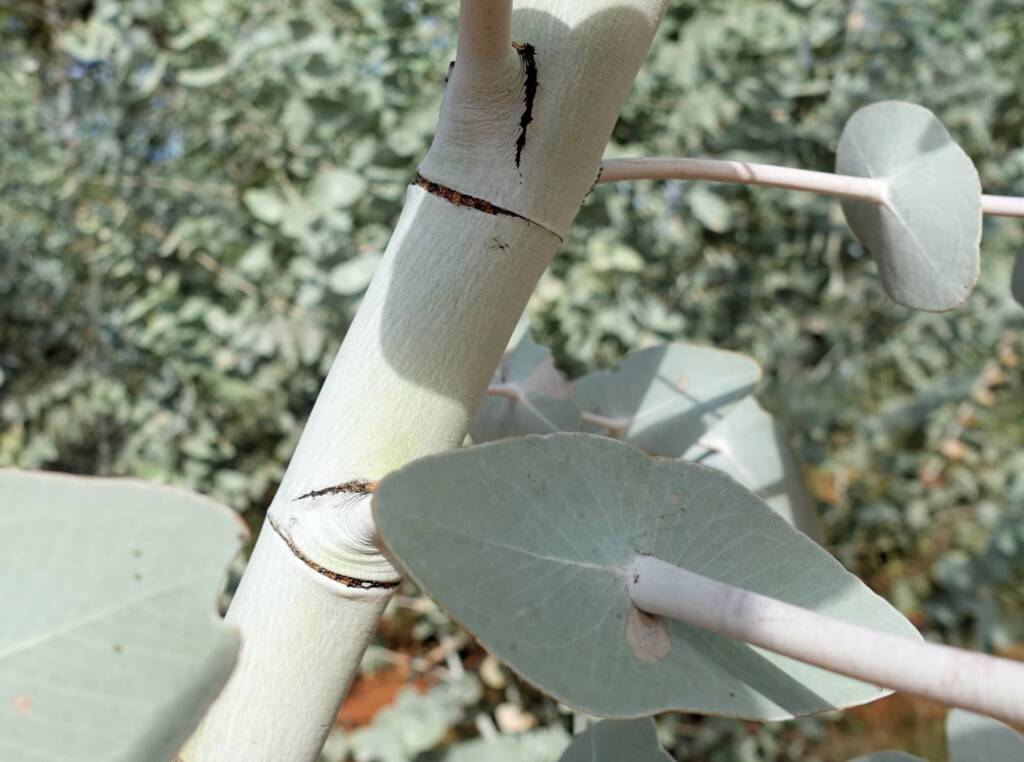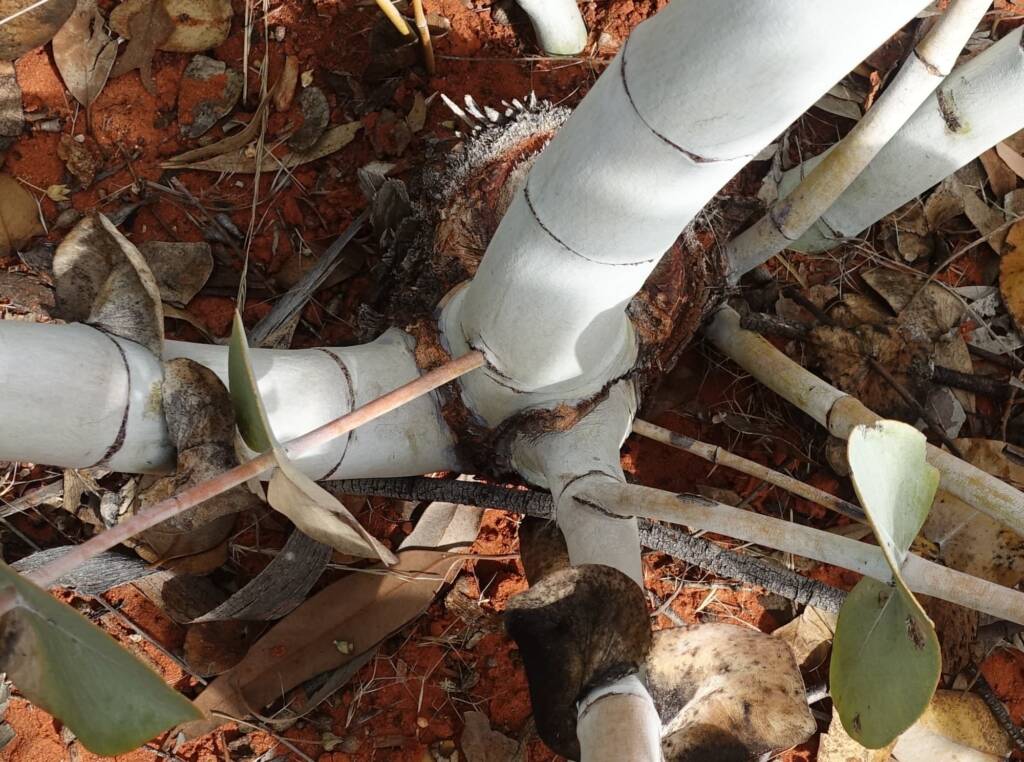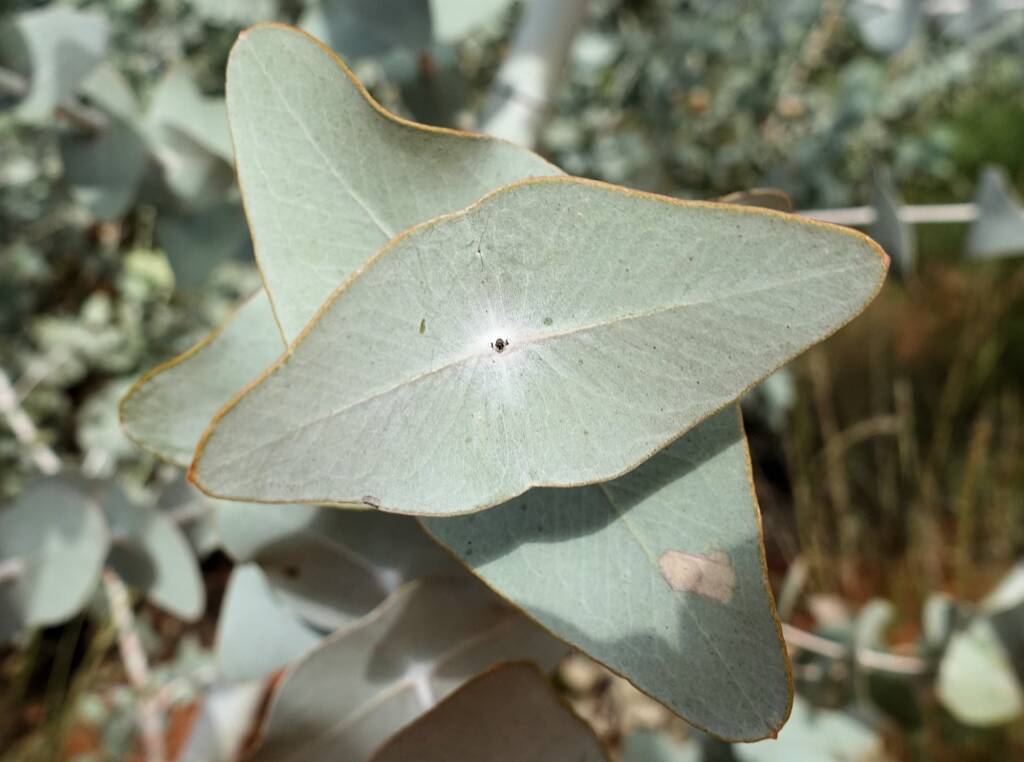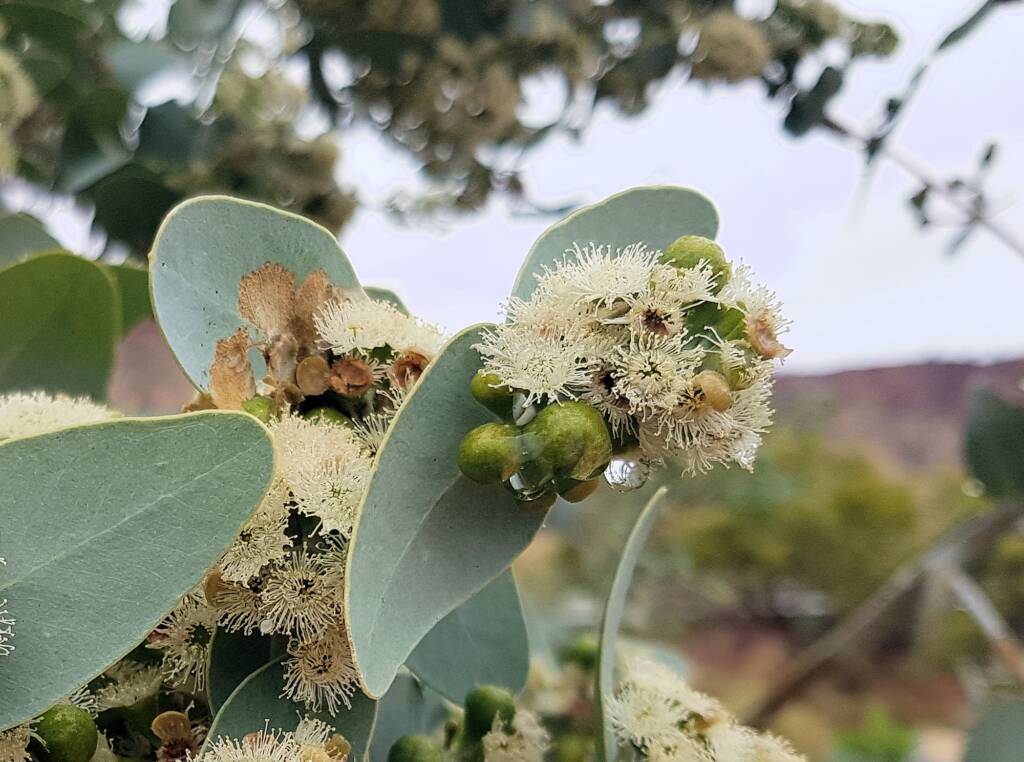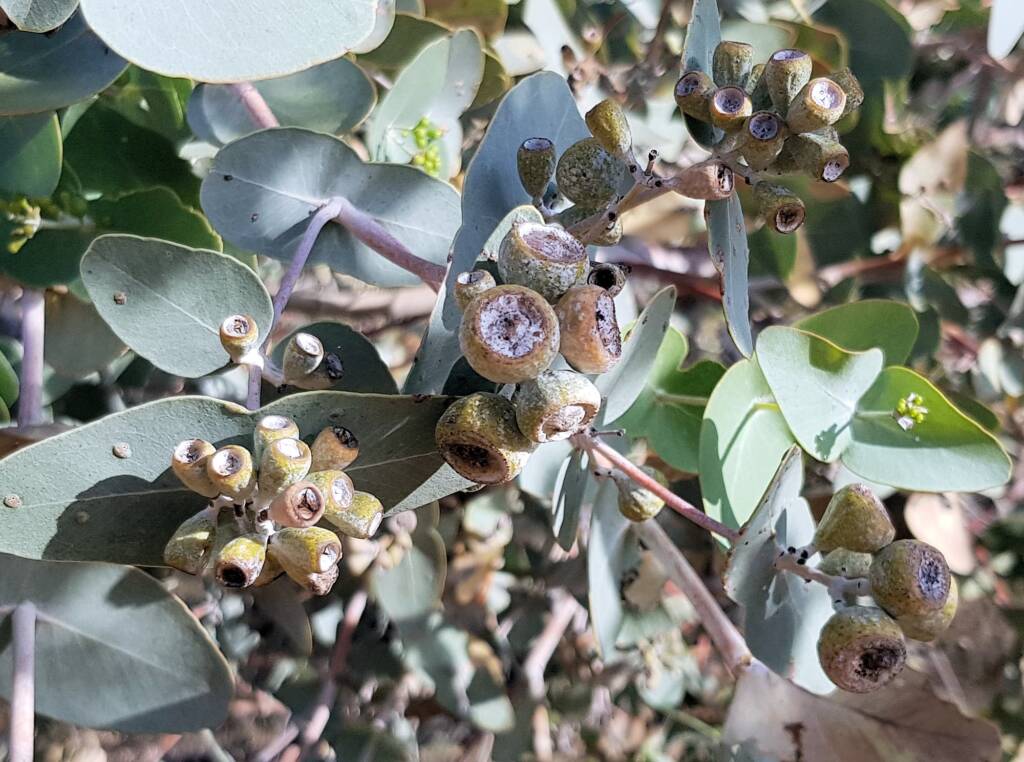EucalyptusEucalyptus Index Corymbia aparrerinja (Ghost Gum) Eucalyptus camaldulensis (River Red Gum) Eucalyptus erythrocorys (Red-capped Gum) Eucalyptus gamophylla (Blue Mallee) Eucalyptus infera (Durikai Mallee) Eucalyptus orbifolia (Round Leaf Mallee) Eucalyptus pachyphylla (Red-bud Mallee) Eucalyptus platypus (Coastal Moort) Eucalyptus woodwardii (Lemon-flowered Gum)
The Blue Mallee (Eucalyptus gamophylla), is native to the Northern Territory, South Australia and Western Australia. They are found growing on sandplains, sand dunes and in stony spinifex country. Often seen growing south of Alice Springs, in places such as Trephina Gorge.

A multi stemmed tree (although occasionally you may see a single trunk tree), that can grow up to 6 metres in height and distinctive blue-grey foliage. Known to have more or less smooth white to cream-coloured bark, it also has brown bark that is shed in short ribbons. Sometimes you will see at the base of the tree, the bark is rough, fibrous and stringy.
This eucalypt is usually seen with juvenile foliage, rounded with two opposite leaves fused at the base. The first pair of juvenile leaves are narrow-lanceolate (narrow oval shape tapering to a point at each end), followed by progressively broader more shortly petiolate leaves (leaf stalks or petioles that attach the leaves to the stem), becoming suborbicular (nearly circular) and connate (a leaf shaped as though the bases of two opposite leaves had fused around the stem). The adult leaves are rarely seen on this plant. The leaves are popular in floral displays (especially indigenous floral displays). The seeds were used as an Aboriginal food. The seeds themselves are relatively large and are separated from the inedible chaff.1
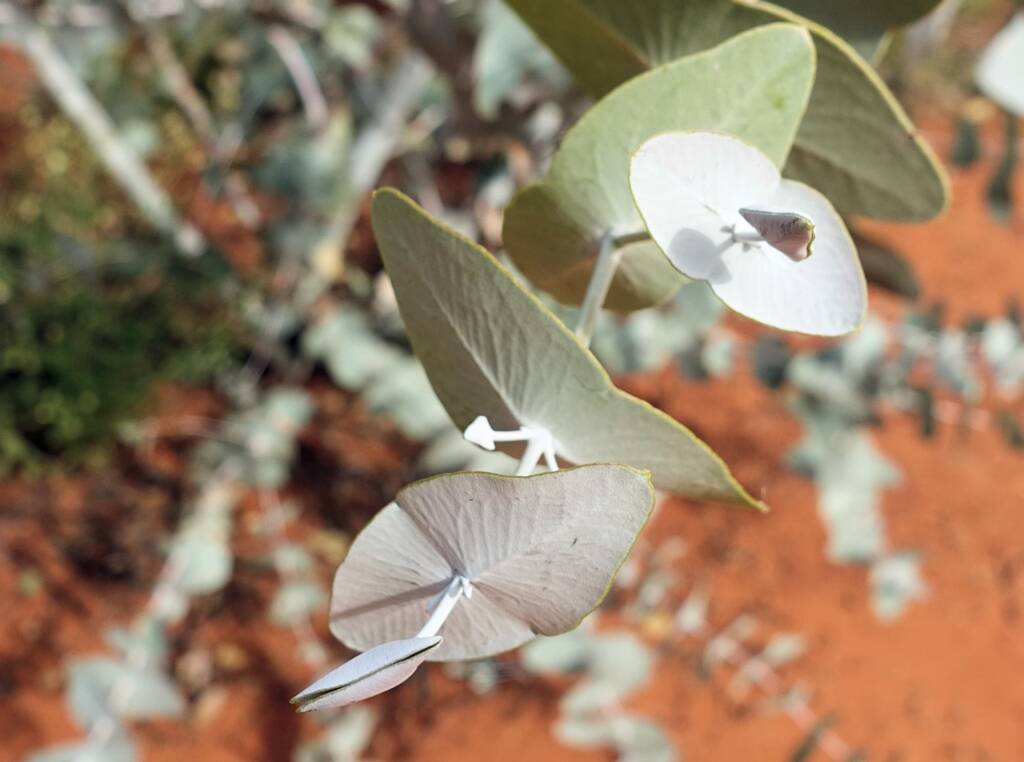
The Blue Mallee has creamy white flowers, with flower buds in groups of three, cylindrical to barrel-shaped fruit, that appears four-sided in cross section. The flower appear from October to November, although it does flower after rains.
Common name
Blue Mallee, Blue Leaved Mallee, Blue-leaved Mallee, Twin-leaf Mallee, Twin-leaved Mallee, Warilu.
The Arrernte name is Tyertepe (pronounced CHUR-tup). The Arrernte name refers to the way the stems pass through the leaves, as though speared. Other Aboriginal language names include lweperr (Alyawarr), uleperre, alhelpe (Eastern Arrernte), warrilyu, yilyulpa (Pintupi), warilyu (leaves) (Pitjantajatjara), warrilyi, yilangkiyi, yilangkurunyu, yirlangkurrunyu (Warlpiri).2

- Scientific classification
- Kingdom: Plantae
- Phylum: Charophyta
- Class: Equisetopsida
- Subclass: Magnoliidae
- Superorder: Rosanae
- Order: Myrtales
- Family: Myrtaceae
- Genus: Eucalyptus
- Species: Eucalyptus gamophylla
Footnote & References
- Wildflowers & Plants of Inland Australia, Author Anne Urban, Published by Paul Fitzsimons, Reprinted 2004, ISBN 0-646-41688-X, p145
- Bushfires & Bushtucker, Author Peter Latz, IAD Press, Alice Springs, NT, Reprinted 2004, ISBN 0-949659-96-7, p187
EucalyptusEucalyptus Index Corymbia aparrerinja (Ghost Gum) Eucalyptus camaldulensis (River Red Gum) Eucalyptus erythrocorys (Red-capped Gum) Eucalyptus gamophylla (Blue Mallee) Eucalyptus infera (Durikai Mallee) Eucalyptus orbifolia (Round Leaf Mallee) Eucalyptus pachyphylla (Red-bud Mallee) Eucalyptus platypus (Coastal Moort) Eucalyptus woodwardii (Lemon-flowered Gum)
FloraFlora in Australia Flora Index Acacia Anigozanthos (Kangaroo Paws) Annual Yellowtop Apium prostratum subsp. prostratum var filiforme Apple Bush (Pterocaulon sphacelatum) Australian Bluebell Australian Gossypium Banksia Batswing Coral Tree Billy Buttons Birdsville Indigo Blue Pincushion Bush Banana Callistemon Callitris drummondii (Drummond’s Cypress Pine) Calothamnus quadrifidus Cape Honeysuckle Cassia fistula (Golden Shower) Cattle Bush Common Heath Crotalaria Darwinia wittwerorum (Wittwer’s Mountain Bell) Daviesia oppositifolia (Rattle-pea) Desert Oaks Drumsticks Eremophila Eucalyptus Ficus Flannel Cudweed (Actinobole uliginosum) Georges Indigo Goatshead Burr (Sclerolaena bicornis) Golden Everlasting Goodenia Gossypium Grass and Grasses Grass Trees Grevillea Grey Germander Hakea Kapok Bush (Aerva javanica) Lambertia sp Leptospermum MacDonnell Ranges Cycad Maireana scleroptera Mexican Poppy Minnie Daisy Mistletoe Family Nardoo Native Apricot Nicotiana megalosiphon subspecies sessilifolia Nuytsia floribunda Orange Spade Flower Orchidaceae Parakeelyas (Calandrinia) Pebble Bush (Stylobasium spathulatum) Perennial Yellow Top Pink Everlasting Pink Rock Wort Poached Egg Daisy Portulaca Proteaceae Ptilotus Quandong Resurrection Fern Rosy Dock Ruby Saltbush Santalum Solanum Spike Centaury Spinifex Storkbill (Erodum cygnorum) Striped Mint Bush Sturt’s Desert Pea Sturt’s Desert Rose Tall Saltbush Tangled Leschenaultia Tar Vine Tribulus eichlerianus Upside-down Plant Urodon dasyphylla Variable Daisy Waratah (Telopea) Wertabona Daisy White Cedar (Melia azedarach) White Indigo White Paper Daisy Wild Passionfruit Wild Stock Woolly-Headed Burr Daisy Woolly Bush Yellow-keeled Swainsona
Flora & FaunaFauna Flora Fauna Flora Funga Glossary Funga Related Topics Scientific Classification Backyard Wildlife Floral Emblems of Australia Wildflowers

